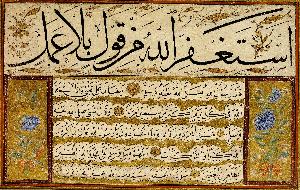Yedikuleli Seyyid Abdullah Efendi
Hâşimîzâde Abdullah Efendi;Yedikuleli Seyyid Abdullah Efendi;Haşimizade Abdullah Efendi
Place: Istanbul
Born: 1670
Death: 1731
Biography:
Early Life and Education
Yedikuleli Seyyid Abdullah Efendi, a renowned Ottoman master calligrapher, was born in 1670 in Istanbul, Turkey. His father, Seyyid Hasan el-Hashimi, was the imam of Imrahor Mosque. Abdullah's family had a strong background in calligraphy, and he was destined to follow in their footsteps. Abdullah studied calligraphy with the great master Hâfiz Osman, who improved the script and developed a layout template for the Ottoman Empire. This mentorship played a crucial role in shaping Abdullah's future as a skilled calligrapher.
Career Highlights
* Appointed as the instructor of calligraphy at the Topkapi Palace in 1708, where he taught Egrikapili Mehmed Rasim Efendi * Wrote many copies of the Qur'an, showcasing his exceptional skill and dedication to the art * Became a favorite of Sultan Ahmed III, who was intrigued by Abdullah's ink and sent a messenger to learn its secret
Notable Works and Legacy
* Kıt'a (single piece), a remarkable example of Abdullah's calligraphy, is now part of the Sakıp Sabancı Museum's collection in Istanbul, Turkey * His work has been featured in various exhibitions, including the Metropolitan Museum of Art's "Letters in Gold: Ottoman Calligraphy from the Sakıp Sabancı Collection"
Importance and Influence
Abdullah's contributions to Ottoman calligraphy are undeniable. His work has been widely recognized, and his influence can be seen in many subsequent calligraphers. As a master of his craft, Abdullah's legacy continues to inspire artists and art enthusiasts alike.
- View more works by Yedikuleli Seyyid Abdullah Efendi on Wikioo.org
- Explore the Ottoman Empire's art movement and its significance in the art world on The Ottoman Period Art Movement
- Discover more about Hâfiz Osman, Abdullah's mentor, and his contributions to Ottoman calligraphy on WikiArt.org
References
* Yedikuleli Seyyid Abdullah Efendi - Wikipedia * Kıt'a (single piece) by Yedikuleli Seyyid Abdullah Efendi on Wikioo.org

